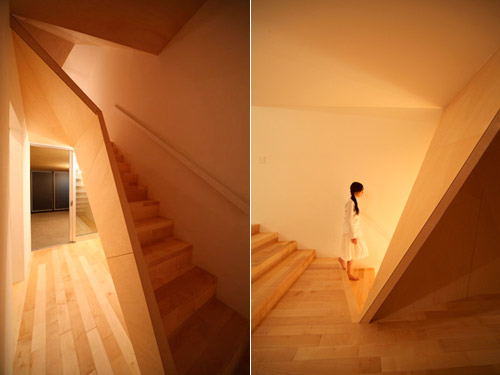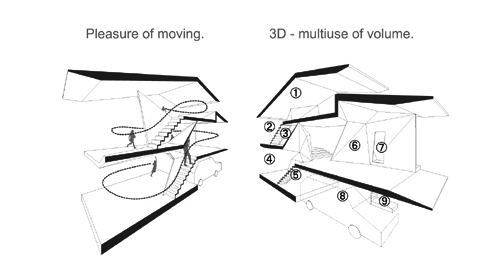Japanese architects kentaro takeguchi and asako yamamoto of alphaville
have recently completed 'new kyoto house' in japan.
This is a residential house located on a narrow site in the centre of kyoto, the old
capital of japan. the area is lined with traditional wooden townhouses named 'machiya'.
While inheriting the advantages of townhouses, the architects intended to overcome
their drawbacks and create a comfortable and enjoyable space.
have recently completed 'new kyoto house' in japan.
This is a residential house located on a narrow site in the centre of kyoto, the old
capital of japan. the area is lined with traditional wooden townhouses named 'machiya'.
While inheriting the advantages of townhouses, the architects intended to overcome
their drawbacks and create a comfortable and enjoyable space.
The most characteristic feature of this house is the polyhedral form of the partition walls.
they are not made by intuition but are based on logical concepts and perform multiple
functions.
First, the partition walls, normally extended in the vertical and horizontal directions, have
multiple dimensions and loosely connect the rooms on the three floors. the space thus
created is one continuous room with dynamic nuances: it is simultaneously spacious
and heterogeneous.
Second, the partition walls serve as reflectors of natural light. they softly reflect the natural
light coming from both the north and south sides and bring it to the otherwise dark interior
of the building.
Finally, the partition walls blur the boundary between architecture and furniture,
thus stimulating perception and behaviour.
Because of the landscape regulations and the physical context of the neighbourhood,
the architects inherited the traditional form and composition of townhouses. The wooden
structure of townhouses cannot afford to have large openings on the short sides of
the building as well as on floors. Consequently, the interior is dark and communications
of people are limited to the horizontal direction. in this project, it is the steel rigid frame
and the polyhedral partition walls that overcome the drawbacks of typical townhouses.
large openings on the walls and the floors, along with the partitions, allow natural light
and encourage three dimensional communications and movements.
thus stimulating perception and behaviour.
Because of the landscape regulations and the physical context of the neighbourhood,
the architects inherited the traditional form and composition of townhouses. The wooden
structure of townhouses cannot afford to have large openings on the short sides of
the building as well as on floors. Consequently, the interior is dark and communications
of people are limited to the horizontal direction. in this project, it is the steel rigid frame
and the polyhedral partition walls that overcome the drawbacks of typical townhouses.
large openings on the walls and the floors, along with the partitions, allow natural light
and encourage three dimensional communications and movements.
project info:
site area: 78.68 m2
building area: 44.00 m2
gross area: 104.66 m2: (1f: 44.00 m2, 2f: 44.00 m2, 2f: 16.66 m2)
building coverage ratio: 55.92%
floor area ratio: 133.02%
building scale: 3 stories
parking capacity: 1 parking space (1f: 13.82m2)
structure system: steel structure
period of design: 12,2008 - 9,2009
period of construction: 9,2009 - 04,2010
site area: 78.68 m2
building area: 44.00 m2
gross area: 104.66 m2: (1f: 44.00 m2, 2f: 44.00 m2, 2f: 16.66 m2)
building coverage ratio: 55.92%
floor area ratio: 133.02%
building scale: 3 stories
parking capacity: 1 parking space (1f: 13.82m2)
structure system: steel structure
period of design: 12,2008 - 9,2009
period of construction: 9,2009 - 04,2010
Via Designboom

















No comments:
Post a Comment